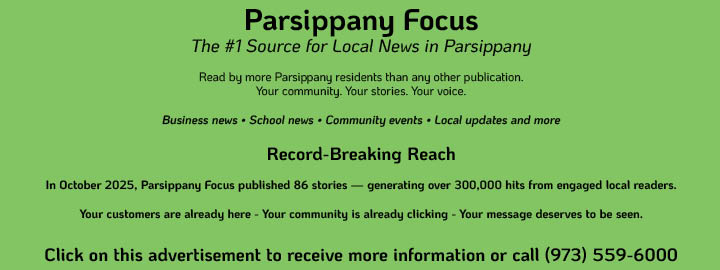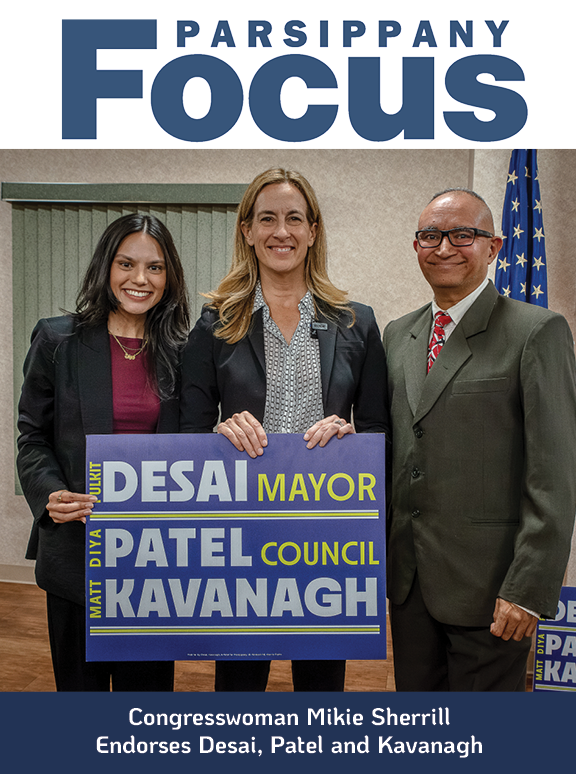 Dear Editor:
Dear Editor:
It is quite disturbing to realize Parsippany’s senior most Councilman and most likely his allies and members of the present administration do not believe nor comprehend the situation and present dilemmas of sustainability concerning water and landscapes; statements made that no water problems exist in Parsippany and that somehow only land development needed or not is good for the township, because of tax ratables and jobs is where Parsippany should be in this time and place.
So they say any landscape any proposal dam the actual facts concerning that landscape. Waterview because of it being privately owned, and along Highway Route 46 is syllogistically condemned through a narrow minded induction away from its natural assets, character and proper place in the ecology of biodiversity, ground water recharge, flood control, steep slopes and forests that enhance a traditional neighborhood, and ensure long-term water health through, its unique features identified in a Troy Brook Storm water study. Loss of this landscape will spell long-term future costs in infrastructure and water health through injury to sustainability of which Waterview landscape is an aid and asset in our waters quality and quantity. It’s destruction for market speculation land development, will surely cost tax-payers later and would bring immediate demise of the quality of life here. No new land development of a corporate market nature is needed anywhere in the region or Parsippany-Troy Hills itself.
Let us examine our water situation and some facts most people and official ignore this information comes from the NJDEP and Highlands Council. “Water use restrictions are used routinely for conservation. In the case of Parsippany, it is a buried valley aquifer with heavy drawdown during summer months and limited rate of recharge to the aquifer. If you reference the deficit/surplus table you will notice that the system has contracts to purchase water from JCMUA & MCMUA. Without these contracts in place, Par-Troy would have a shortfall in available water”. Now examine this statement from NJ Division of Watersupply & Geoscience. “
The Division of Water Supply & Geoscience does not track discharge by watershed, we account for diversion not discharge. Safe yield is a term associated with the yield of a surface water system through the drought of record. Parsippany-Troy Hills does not have surface water sources but they do purchase water from Jersey City which uses the Boonton Reservoir”
Here in lies the contradiction; notice Parsippany-Troy Hills does not have surface water sources; they purchase water. These sources are now privately owned and in the future especially when because of drought or excessive drawdowns water becomes less and shared by many sources, not only Parsippany water prices will surely increase. Homeowners will have to share in the costs for all water use, be it drinking water or water used for lawns or other desires not of a thirst or washing necessity. The thing to remember is “Without these contracts in place, Par-Troy would have a shortfall in available water” a water deficit which it does in fact have of its own without the sources.
Therefore we need to understand the limitations of the NJDEP water regulations. Just because we adhere to them, doesn’t mean we will have enough water. The regulations do not look at the sustainability of the aquifer.This explains how we have arrived at the present situation with conflicting viewpoints. The administration advises that the borough meets the NJDEP regulations and could continue to meet the regulations no matter what new developments.
Let us thanks to Highlands Council examine this contradiction further.
1. Sustainability: Let’s start with the basic assumption that our goal is to keep our aquifer at historic water levels by not withdrawing more water than the system can safely sustain over time. In other words we will not add to a water deficit over the long-term.
2. Water Deficit: Before we increase the demand for water, we need to determine whether current water withdrawals exceed the natural replenishment of the aquifer. We may decide to look into this further, but it appears that the experts are telling us that indeed we do have a water deficit. The Environmental Commission reported on March 10, 2014 that calculations by the New Jersey Highlands Council for the Regional Master Plan determined that our watershed has a significant water deficit.
The abstract of the Regional Master Plan states the following: “A central goal of the Regional Master Plan is to determine the amount and type of human development and activity that the ecosystem of the Highlands Region can sustain while still maintaining the overall ecological values thereof, with special reference to surface and ground water quality and supply. Based on an analysis of available methods and available data, the Low Flow Margin method was selected as the best scientific approach available at this time for estimating capacity of ground water supplies across the entire Highlands Region, to maintain both ecological flow needs and estimate sustainable levels of human consumption.”
Thus, as stated above, a central goal of the Regional Master Plan was to come up with data on the capacity of ground water supplies in the Highlands. Their 2007 Water Resources Technical Report on net water availability found a water deficit in our watershed and in many others. See map attached.
3. NJDEP Water Regulations: Your next question might be to ask how has it come about that we have a water deficit when the borough has been meeting the water diversion limits and firm capacity* regulations of NJDEP.
The answer to this inconsistency lies in the fact that the NJDEP regulations are based on a different set of criteria than are discussed above in items 1 and 2. NJDEP looks at past water use in the Borough and the adequacy of our wells’ pumping equipment. NJDEP is saying to us, if the water is there, these are the regulations for how much you can pump out. NJDEP is not addressing the important question of how much can safely be withdrawn from the system over time.
We must say to ourselves of these two facts concerning water which one should we all use in relation to deciding, actual need in new land development, where should the development go, what landscape should not be developed, and most importantly what criteria for water conservation and method of allocation should be allowed in local Planning Board Standards or revisions?
It now should be obvious that any official claiming there are no problems with water and that Parsippany has plenty of it is not quite a truth but a fiction favoring corporate developers in a short-term sense costing tax payers and residents in a long term outcome. Water first and foremost is a common public trust and belongs to us all. Parsippany being in the Highlands be it planning zone, or not has a responsibility to do what is best in landuse matters by ignoring its responsibility to long term water health and developers effects on water and landuse is simply adding to the accumulative sure to come future problems.
Our new Master Plan update of 2014 has done little if anything to revise our community defenses in its long term quality of life our zoning, ordinances and regulations remain virtually unchanged. No new safeguards or proactive measures were incorporated; we still stand in a state of reaction rather than being proactive. Our watershed is in deficit as many others now are. In 10 years the whole of New Jersey will be. New Jersey is going backwards is continued sprawl, in not being responsible for maintaining and repairing water infrastructure, 25% or more water is lost to leaks and seeps, and many sewer systems of the State suffer ‘combined source overflow” where sewage and stormwater runoff mixes as it empties into streams and rivers; one gallon of clean water and one of dirty equal two gallons of dirty water. We as a people have ignored water for too long; it is now catching up with us all.
Parsippany’s biggest mistake was and is not continuing the regional Master Plan Conformance as its benefits far outweigh any possible drawbacks. In fact regional Conformance has more transparency and encouragements in citizen participation and education. Corporate developers are given many opportunities, however best management practices and proper land use criteria are all in a higher state that in the long run preserves, protects and enhances any required land use. Home Rule is developers rule; saving money while avoiding lawsuits is not in the best interest of our Township. Conformance also gives legal protections why would anyone deny the people in the here and now and the future this advancement? Ask our senior Councilmen; who says what is good for the region may not be good for Parsippany, absurd! Unless one is powerless or in cahoots; which is it? Conformance would be instilling power, while “home rule” obviously is in cahoots with outside forces, caring less for anything less than their interest. The lessons of RD Realty and Waterview still unlearned.
Waterview Landscape can be saved by good leadership and using water as the element of salvation in being human not corporate. One additional fact from Clean Water Action, right now in the US 1 in 3 and in NJ 1 in 2 people suffers either in additional costs or health issues associated with water supply. We are not exactly sure what is in our water supply. Besides pollution urban decline and sprawl are the main culprits.
Nick Homyak
Lake Hiawatha, NJ 07034














